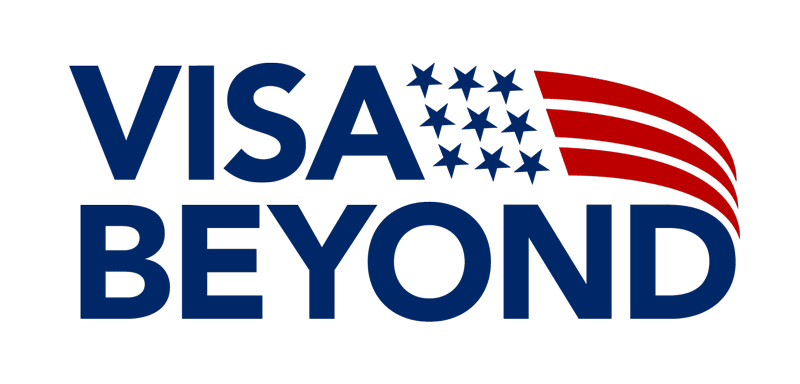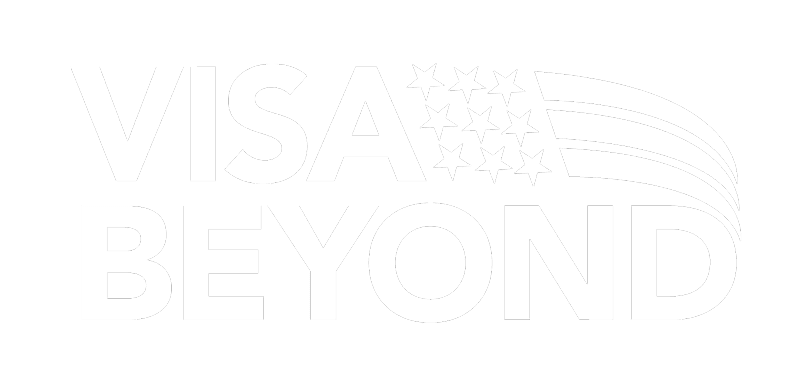EB-3 Visa:
A Complete Guide
for Skilled Workers.
EB-3 visa grants U.S. permanent residency to skilled, professional, and unskilled workers with a valid job offer.
EB-3 visa not only covers skilled workers but also allows unskilled workers to apply, making it one of the most accessible employment-based visas.
Job Stability
Secured through
full-time job offer.
Broad Eligibility
Open to skilled, professional,
and unskilled workers.
Family Access
Dependents can live
and study in the U.S.
Path to Green Card
Easily transition to
permanent residency.
Job Flexibility
Easily switch employers
with a new petition.
Client
Satisfaction
Years
in the business
EB-3 Visa:
Overview and Key Benefits
The EB-3 visa is an employment-based immigrant visa that allows foreign nationals to work permanently in the United States. It is an ideal option for skilled workers, professionals, and even unskilled workers seeking permanent residency. The EB-3 visa is popular due to its broad eligibility criteria and the ability to bring family members along. Key benefits include:
Permanent Residency:
Grants U.S. Green Card to the primary applicant and eligible family members (spouse and unmarried children under 21).
Job Security:
The visa is tied to a permanent job offer, ensuring long-term employment.
Diverse Job Eligibility:
The EB-3 visa covers a wide range of job categories, from skilled labor to professional roles and unskilled jobs.
Pathway to Citizenship:
After obtaining a Green Card, you can apply for U.S. citizenship after five years of residency.
EB-3 Visa Success Rate.
The success rate of the EB-3 visa is generally high, especially when applications are submitted with complete and accurate documentation.
00%
Depending on the
applicant’s field
EB3 Visa Application Costs and Processing Timeline
An overview of fees and processing times for applying to the O1 Visa program, designed for individuals with extraordinary abilities.
Application Fees
- Form I-140 Filing Fee: $700
- Labor Certification (PERM) Fees: paid by the employer
- Form I-485 Filing Fee: $1,140
- Biometrics Fee: $85
- Visa Issuance Fee: Varies by country
- Premium Processing Fee: $2,500
Application Timeline
- Standard Processing Time: 12 to 24 months
- Expedited Processing: 15-day processing available for Form I-140
FAQs
About EB-3 Visa.
How long does it take to get an EB-3 visa?
Processing times for the EB-3 visa vary based on your country of origin and the availability of visa numbers. It can take anywhere from 1 to 3 years, or longer if there’s a backlog for your country.
Can EB-3 visa holders bring their family to the U.S.?
Yes, EB-3 visa holders can bring their spouse and unmarried children under 21 to the U.S. as dependents. They will be eligible for green cards and, in some cases, the spouse can apply for a work permit (H-4 EAD).
Can an EB-3 visa holder apply for U.S. citizenship?
Yes, after holding a green card for 5 years, EB-3 visa holders can apply for U.S. citizenship through naturalization, provided they meet all eligibility requirements, including residency and good moral character.
What is the difference between EB-3 and EB-2 visas?
O-1 Visa holders are subject to U.S. tax laws and must file taxes based on their residency status and income earned in the U.S.
What types of jobs qualify for the EB-3 visa?
A wide variety of jobs qualify for the EB-3 visa, ranging from healthcare professionals, engineers, and IT specialists for skilled and professional categories, to positions like farmworkers, cleaners, and construction laborers for unskilled workers.
Clients we
work for.
















What is the EB-3 Visa? A Complete Overview
The EB-3 visa is a third-preference employment-based immigrant visa that allows U.S. employers to sponsor foreign nationals for permanent residency. It is designed for individuals who fall into one of three categories: skilled workers, professionals, or unskilled workers. Here’s a breakdown of what makes the EB-3 visa unique:
- Skilled Workers: Jobs that require a minimum of two years of training or experience.
- Professionals: Jobs that require at least a U.S. bachelor’s degree or its foreign equivalent.
- Unskilled Workers: Jobs requiring less than two years of training or experience, but the job must be permanent and not temporary.
EB-3 visa requires the U.S. employer to demonstrate that there are no qualified U.S. workers available for the job by obtaining a PERM (Program Electronic Review Management) labor certification from the Department of Labor.
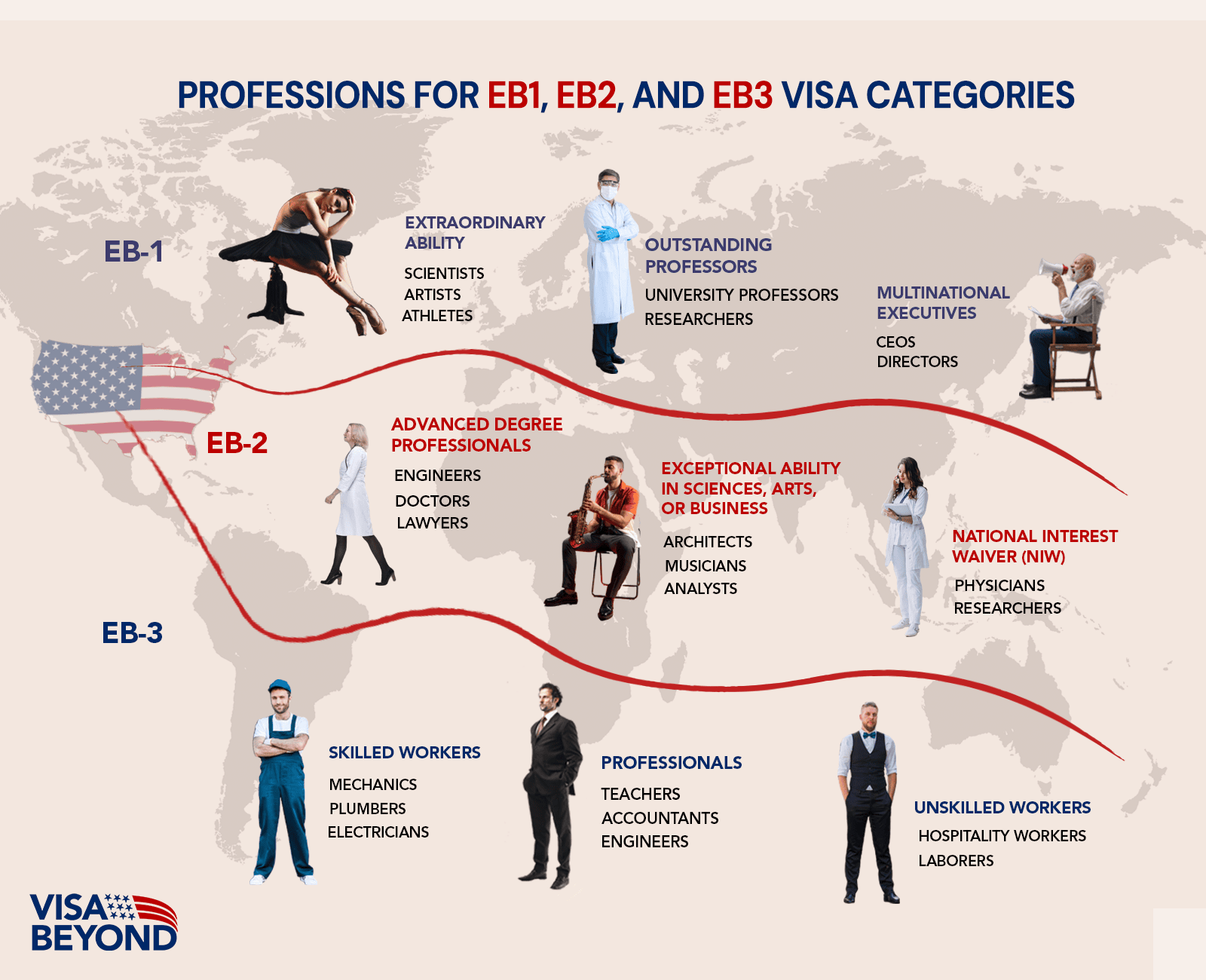
Differences Between EB-3 and Other Employment-Based Visas
The EB-3 visa differs from other employment-based immigrant visas like EB-1, EB-2, and H-1B in several key ways. Here’s a comparison to help you understand how the EB-3 visa stands apart:
The EB-3 visa offers less stringent requirements compared to the more demanding EB-1 and EB-2 visas. While EB-1 and EB-2 visas require higher levels of education, extensive experience, or extraordinary abilities, the EB-3 visa has lower barriers to entry, making it a more accessible option for skilled workers, professionals, and even some unskilled workers who have a valid job offer in the U.S.
Why EB-3 Visa is a Popular Option for Skilled Workers?
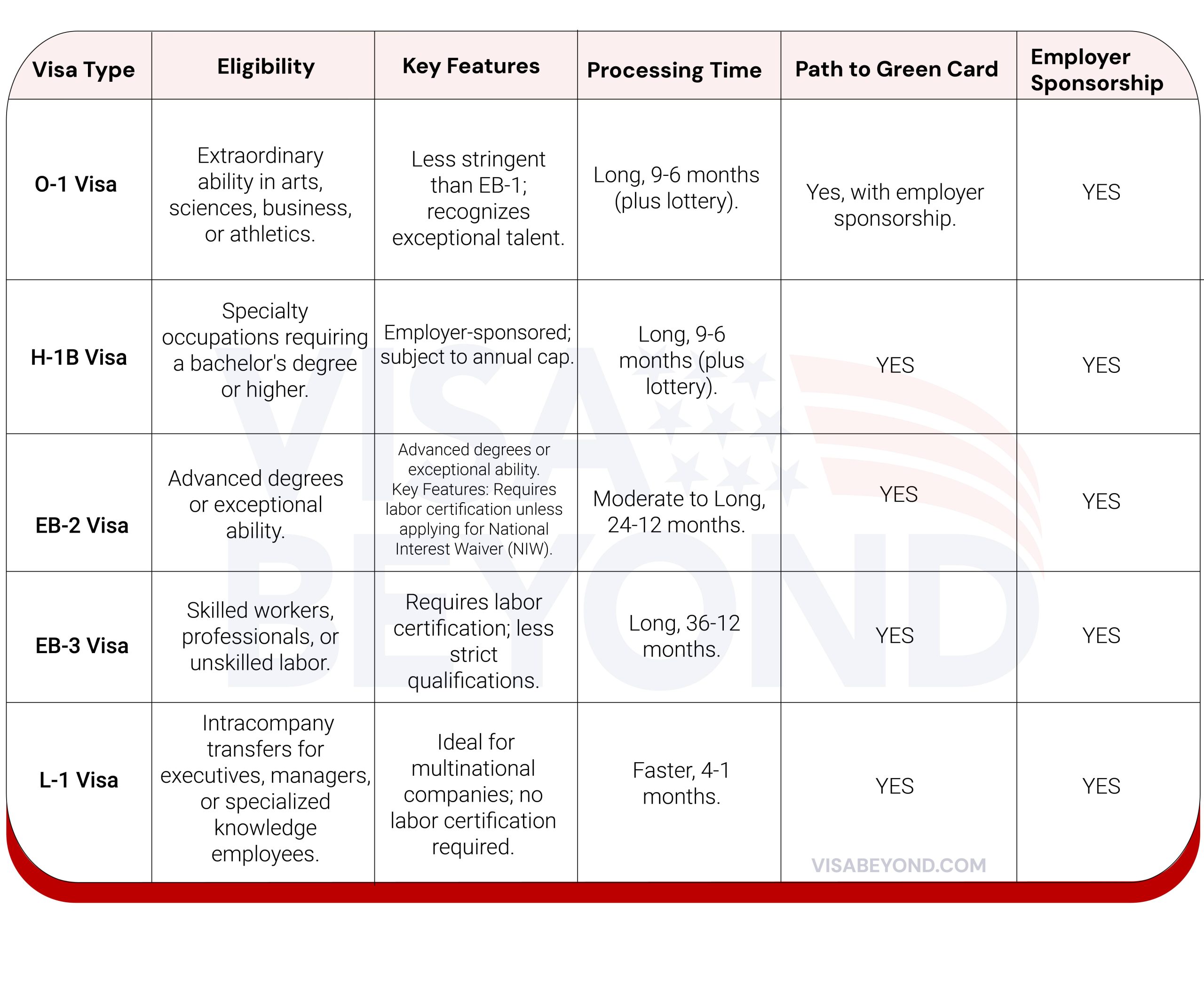
EB-3 Visa Categories and Eligibility Requirements
EB-3 visa has three categories: Skilled Workers, which require at least two years of job experience or training for a permanent, non-seasonal position; Professionals, which require a U.S. bachelor’s degree or its foreign equivalent for a job that necessitates such qualifications; and Unskilled Workers (Other Workers), which applies to permanent, full-time jobs that require less than two years of experience or training.
Who Qualifies for the EB-3 Visa? Eligibility Requirements
Eligibility for the EB-3 visa depends on meeting the specific criteria for each of the three categories:
- Job Offer: You must have a permanent job offer from a U.S. employer.
- Labor Certification (PERM): Your employer must demonstrate that no qualified U.S. workers are available for the job.
- Education or Experience:
- Skilled Workers: Minimum two years of experience or training.
- Professionals: Bachelor’s degree or foreign equivalent.
- Unskilled Workers: Less than two years of training or experience.
Skilled Workers, Professionals, and Unskilled Workers: Key Differences
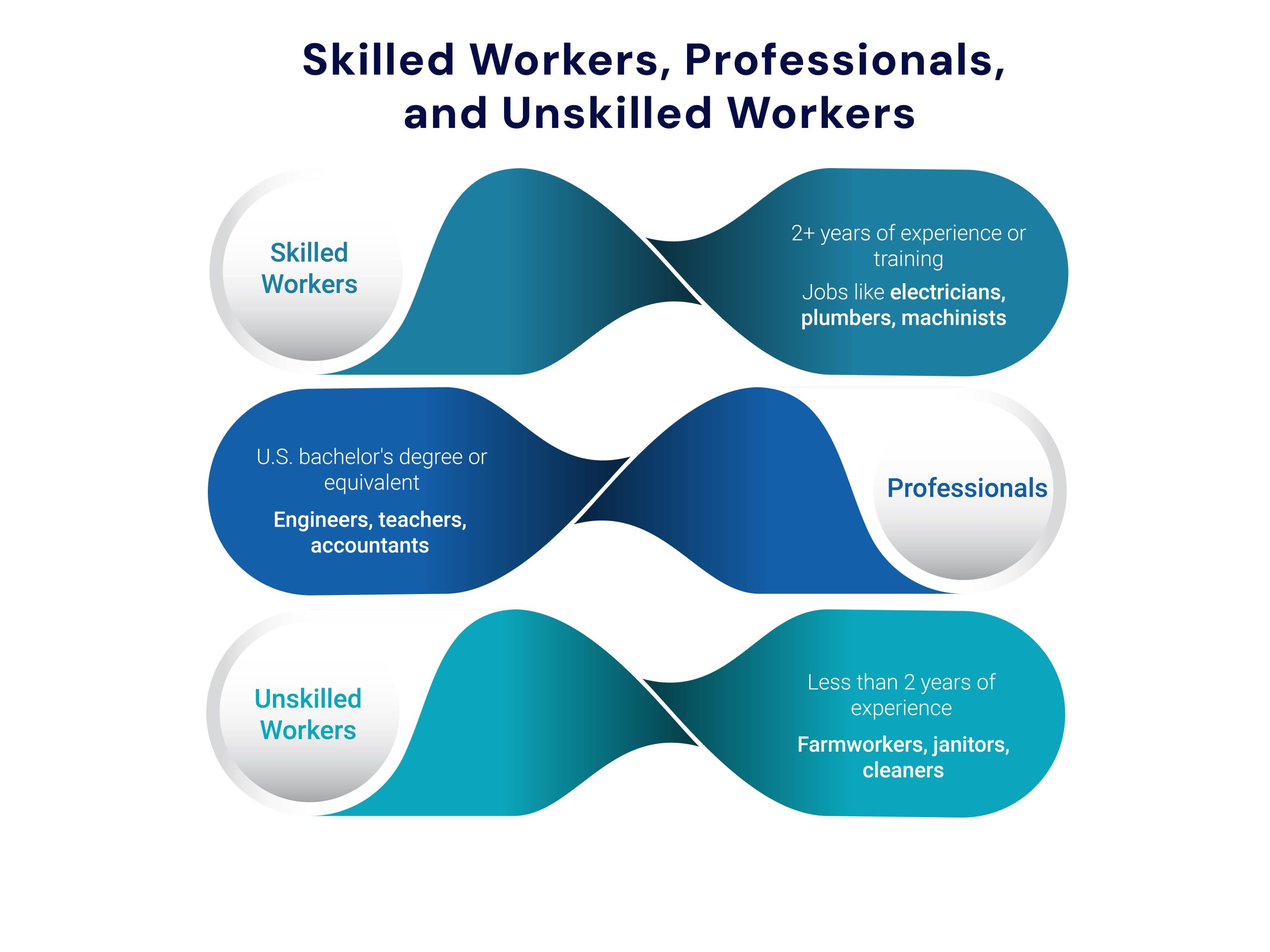
What Jobs Qualify for the EB-3 Visa?
The EB-3 visa covers a broad spectrum of jobs across various industries. Qualifying jobs include:
- Skilled Workers: Positions in manufacturing, healthcare (e.g., nurses, medical technicians), construction (e.g., electricians, carpenters).
- Professionals: Roles requiring a degree, such as engineers, IT professionals, teachers, and accountants.
- Unskilled Workers: Jobs in agriculture, personal care, hospitality, and cleaning services.
EB-3 Visa Application Process and Timeline
To apply for the EB-3 visa, you’ll need a permanent job offer from a U.S. employer, who must first obtain a labor certification from the Department of Labor. The employer will then file Form I-140 on your behalf. Depending on your location, you’ll either file for adjustment of status if in the U.S. or apply for an immigrant visa through consular processing if you’re abroad.
How to Apply for an EB-3 Visa: A Step-by-Step Guide
Once approved and the priority date is current, the applicant can file Form I-485 (if in the U.S.) or apply for consular processing (if abroad). A medical exam and interview may be required. Upon successful completion of all steps, the applicant and eligible family members receive green cards for permanent residency.
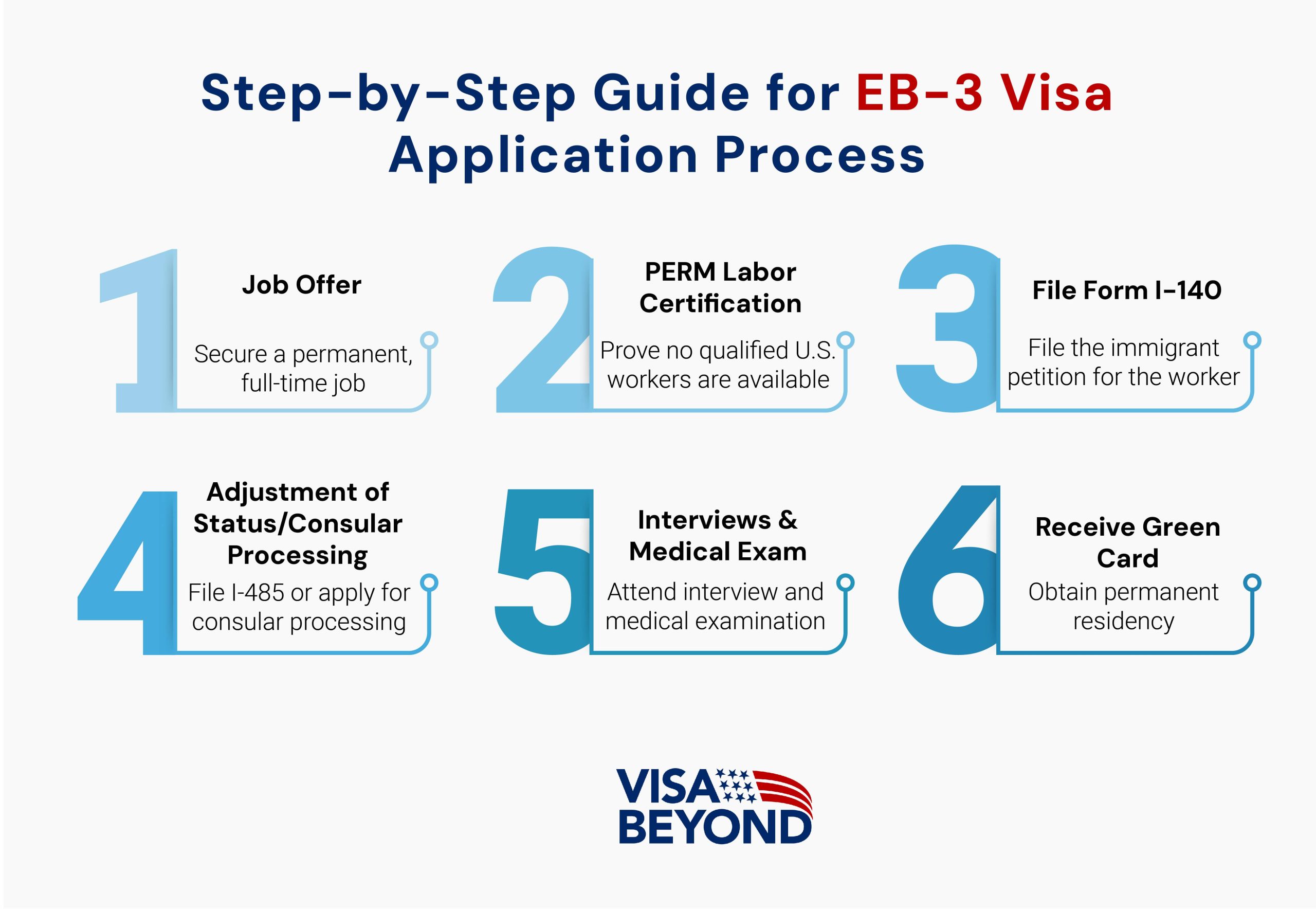
Filing Form I-140 for EB-3 Visa: What You Need to Know
Form I-140 is a crucial step in the EB-3 visa application process, as it is the employer’s petition for the foreign worker to be classified as an immigrant. Here’s what you need to know about filing this form:
Who Files It:
The U.S. employer must file Form I-140 on behalf of the foreign worker. The employee cannot self-petition for the EB-3 visa.
Priority Date:
The filing date of Form I-140 sets the priority date. This date is important as it determines when you can proceed with the next steps of your application based on visa availability. The U.S. Department of State publishes monthly Visa Bulletins that show the priority dates for each visa category.
Supporting Documentation:
Employers must provide documentation to support the petition, such as proof of the labor certification (PERM), job offer details, and evidence of the employee's qualifications.
Processing Times
Standard processing times for Form I-140 can range from 6-9 months. Employers can opt for premium processing by paying an additional fee, which guarantees processing within 15 calendar days.
Fees:
Filing Form I-140 comes with a base fee of $700, not including any legal or additional processing fees.
EB-3 Visa Application Checklist
A successful EB-3 visa application requires comprehensive documentation at every stage. Here’s a list of essential documents you will need:
PERM Labor Certification
Issued by the Department of Labor, this certification confirms that the employer has made good-faith efforts to recruit U.S. workers for the position.
Form I-140 (Immigrant Petition for Alien Worker)
Filed by the U.S. employer, this petition serves as a formal request to sponsor the foreign worker.
Proof of Education and Experience
- For skilled workers: Certificates and proof of at least two years of experience or training.
- For professionals: Copies of academic degrees or diplomas.
- For unskilled workers: Any relevant documentation related to job training or employment.
Valid Job Offer Letter
This letter must outline the permanent job offer, including salary, job description, and employment terms. The letter must show that the job meets EB-3 requirements.
Medical Examination Records
Required for the adjustment of status or consular processing, this involves an exam by a USCIS-approved physician to confirm you meet the health standards for U.S. residency.
Passport and Birth Certificates
Proof of identity and nationality for you and your dependents.
Proof of Financial Stability
You may need to provide financial records to demonstrate that you and your family won’t become a public charge in the U.S.
Costs and Fees for EB-3 Visa Filing
The EB-3 visa process involves multiple costs and fees that applicants and employers must consider. Below is a breakdown of typical expenses:
- PERM Labor Certification: Costs vary depending on the complexity of recruitment efforts, but expect expenses for job advertisements and attorney fees. This certification is handled by the employer.
- Form I-140 Filing Fee: $700, payable by the employer to file the immigrant petition.
- Form I-485 (Adjustment of Status): If filing within the U.S., the fee for Form I-485 is typically $1,140, plus an $85 biometrics fee.
- Consular Processing Fees: If applying from outside the U.S., consular processing fees range between $325 and $345.
- Medical Examination: Costs for the required medical exam vary by provider, but expect to pay $200-$500.
- Attorney Fees: Many applicants choose to hire an immigration attorney to guide them through the complex process. Legal fees can range from $2,000 to $10,000, depending on the case complexity.
How Long Does it Take to Get an EB-3 Visa?
The processing time for an EB-3 visa can vary significantly based on several factors, including the applicant’s country of origin, employer’s preparation, and USCIS workloads. On average, the EB-3 process can take anywhere from 1 to 3 years. Below are the key timeframes:
- PERM Labor Certification: This initial step can take anywhere from 6 months to over a year depending on DOL processing times and employer recruitment efforts.
- Form I-140 Processing: Once the PERM is approved, Form I-140 can take 6 to 9 months for regular processing. Premium processing, available for an additional fee, ensures a response within 15 days.
- Visa Availability: Depending on your country of origin, you may need to wait for your priority date to become current. Visa Bulletin updates should be monitored monthly to check progress.
- Adjustment of Status or Consular Processing:
- For adjustment of status (within the U.S.), processing can take 8 to 14 months.
- For consular processing (outside the U.S.), the timeline depends on the U.S. embassy or consulate’s workload but typically ranges from 6 to 12 months.
How to Expedite the EB-3 Visa Process
While the EB-3 visa process can be lengthy, there are steps you can take to expedite certain stages:
Premium Processing for Form I-140:
By paying an additional fee, you can have your Form I-140 processed in 15 calendar days rather than the usual 6-9 months. Premium processing costs $2,500.
Ensure Accurate Documentation:
- Delays are often caused by incomplete or incorrect forms and missing documents. Review all forms and evidence carefully before submission.
Hire an Experienced Attorney:
An immigration attorney can help you avoid common mistakes and ensure that each step of the process is handled efficiently.
Stay Informed:
- Keep track of your case status through USCIS updates and monitor the Visa Bulletin regularly to know when your priority date is current.
Priority Dates, Retrogression, and the Visa Bulletin for EB-3 Visa
The EB-3 visa process is driven by priority dates, retrogression, and the Visa Bulletin, which determines when you can proceed with your application. The priority date marks your place in line, while retrogression may cause delays, especially for applicants from high-demand countries. Staying informed by tracking the Visa Bulletin is crucial to navigating this process.
Priority Dates for EB-3 Visa Applications
The priority date for an EB-3 visa is the date the employer files Form I-140 on behalf of the applicant. This date determines your place in the visa queue and is important when demand exceeds available visas. Here’s how it works:
- Priority Date = Filing Date of Form I-140
- Importance: Determines when your visa application can move forward.
- Visa Bulletin: Tracks when your priority date becomes current.
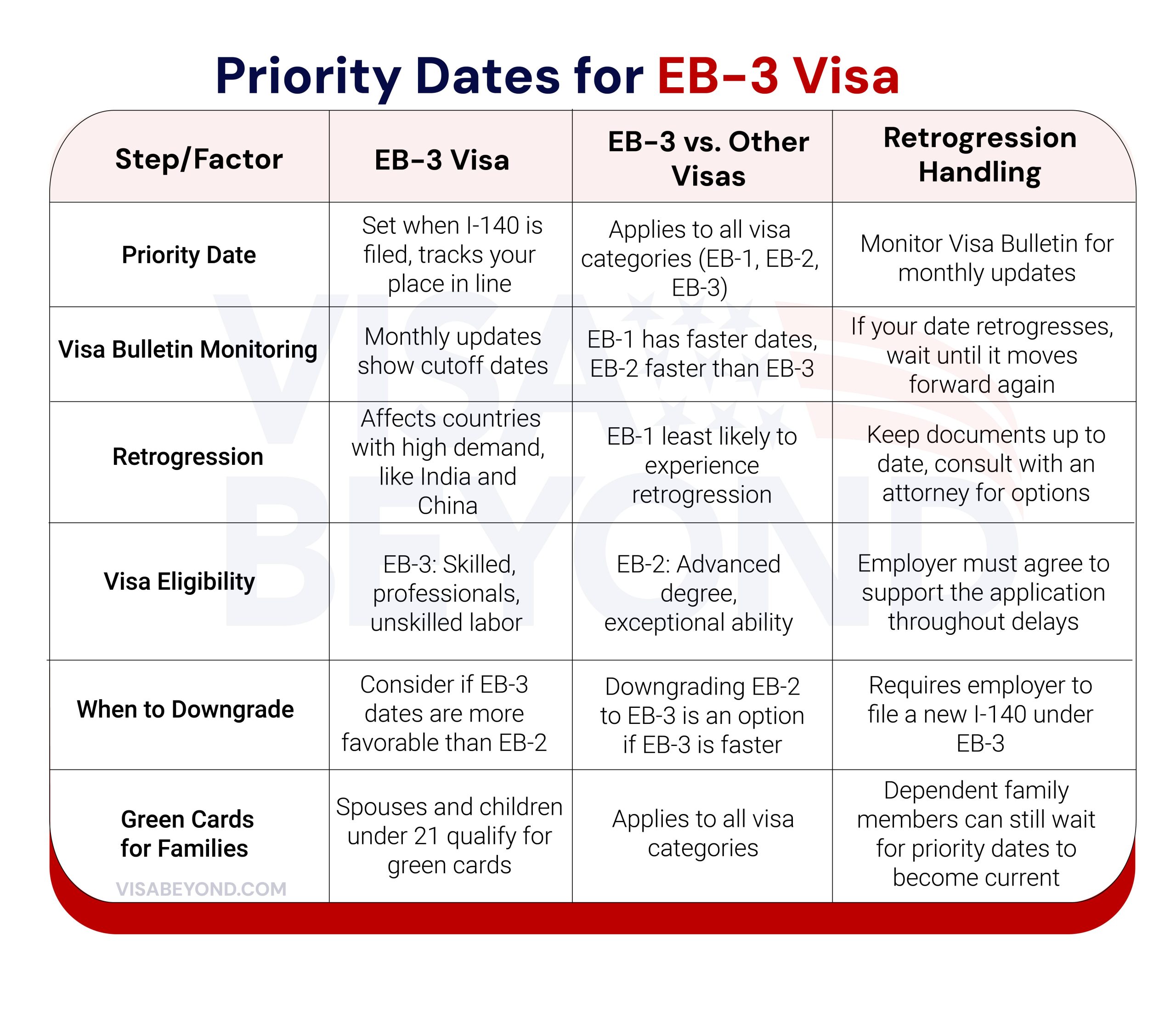
How to Track Your EB-3 Priority Date
Tracking your EB-3 priority date is essential to knowing when you can move forward with your visa application. The Visa Bulletin, published monthly by the U.S. Department of State, provides updates on cutoff dates for different countries and visa categories. Steps to track your priority date:
- Find Your Priority Date: Refer to the I-140 receipt notice.
- Check the Visa Bulletin: Visit the U.S. Department of State’s website to monitor the monthly updates.
- Compare Dates: Check when your priority date becomes current for your country of chargeability.
Retrogression for EB-3 Visa: What It Means and How to Handle It
Retrogression occurs when the demand for EB-3 visas exceeds the annual limit, causing the priority dates to move backward. This affects applicants from countries with high demand, such as India or China. If retrogression impacts your priority date, you will need to wait until it becomes current again. Key points to know:
What is Retrogression?
A backlog of visa applicants causes a delay in processing.
Who is Affected?
Applicants from countries with high demand for visas.
Handling Retrogression
- Keep documentation up to date and continue monitoring the Visa Bulletin.
What to Do If Your EB-3 Priority Date Retrogresses
If your EB-3 priority date retrogresses, you will experience delays in your visa application process. Here’s how to handle it:
- Stay Informed: Regularly check the Visa Bulletin for updates.
- Keep Documents Ready: Ensure all forms, medical exams, and certifications are current.
- Consult an Attorney: Seek advice on maintaining your case status during the waiting period.
Visa Bulletin Updates and Retrogression Predictions for EB-3 Visa Holders
Visa Bulletin updates provide critical insights into visa availability, priority date movements, and potential retrogression. By keeping track of monthly releases, you can plan your next steps and anticipate potential delays. Here’s what to do:
- Check Monthly: The Visa Bulletin is updated each month with the latest priority date cutoffs.
- Watch for Predictions: Some months may see faster movements in priority dates, while others could see retrogression.
- Plan Accordingly: If retrogression is predicted, prepare for potential delays in your application.
Comparing EB-3 with Other Employment-Based Visas
The EB-3 visa is one of several employment-based visa options in the U.S. It is often compared with EB-2 and EB-1 visas, which have different eligibility criteria. Here’s how they compare:
EB-3 vs. EB-2: Key Differences and Similarities
The EB-3 and EB-2 visas serve different applicant pools, with EB-2 requiring higher qualifications. Key differences include:
- EB-2 requires an advanced degree or exceptional ability, while EB-3 is for skilled, professional, and unskilled workers.
- EB-2 typically has faster processing but stricter eligibility criteria.
Both lead to permanent residency but may have different priority date movements.
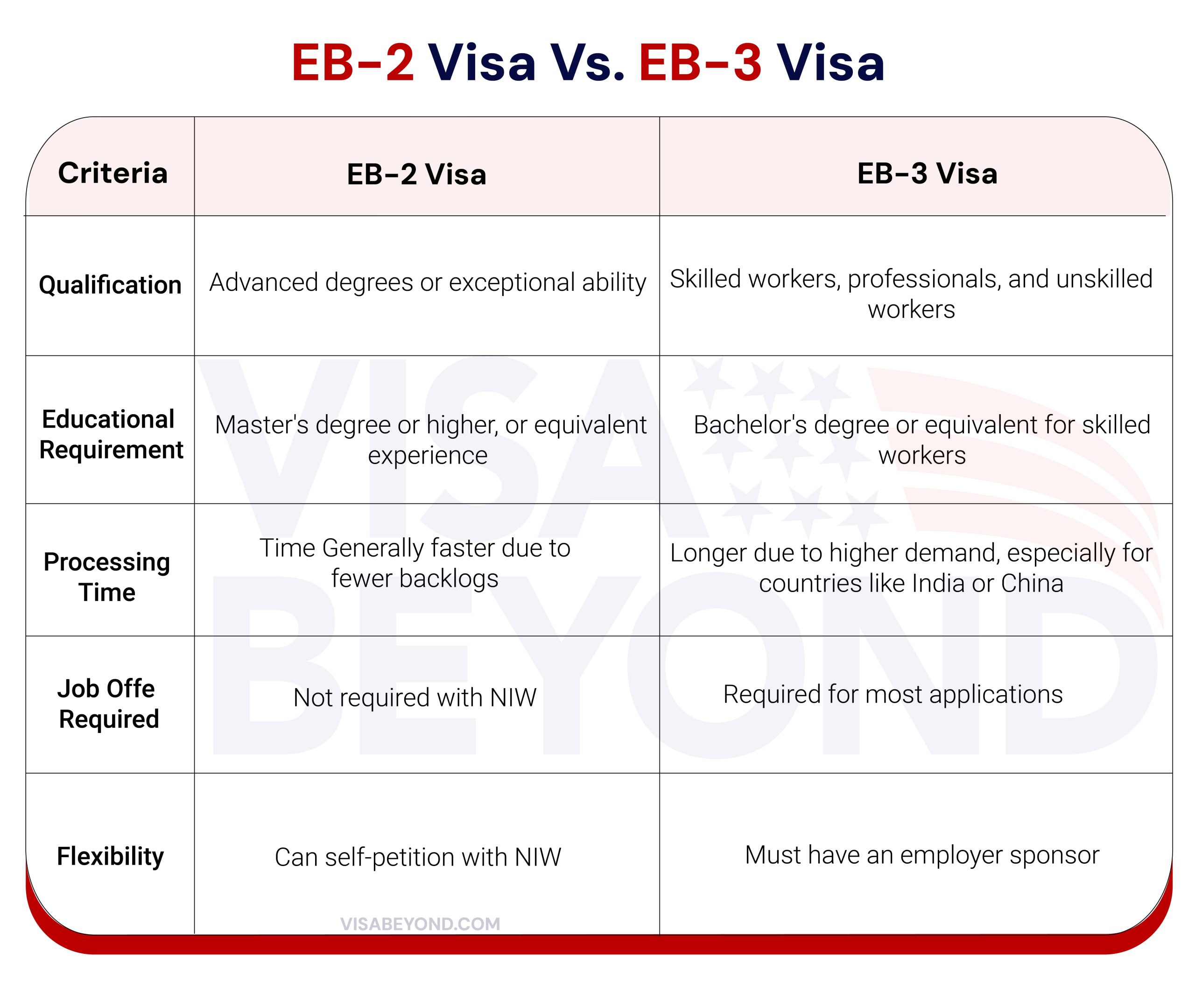
When Should You Consider Downgrading from EB-2 to EB-3?
Downgrading from EB-2 to EB-3 may be an option if EB-3 priority dates are moving faster than EB-2 for your country of chargeability. This strategy helps expedite the green card process. Key considerations include:
- Faster EB-3 Dates: Downgrading can be beneficial if EB-3 dates are more current than EB-2.
- Employer Support: Your employer must support the downgrade by filing a new I-140 under EB-3.
Family Benefits for EB-3 Visa Holders
EB-3 visa holders can bring their spouse and unmarried children under 21 to the U.S., offering them permanent residency, work authorization, and educational opportunities. These family benefits allow for easier integration into U.S. life while the primary applicant works.
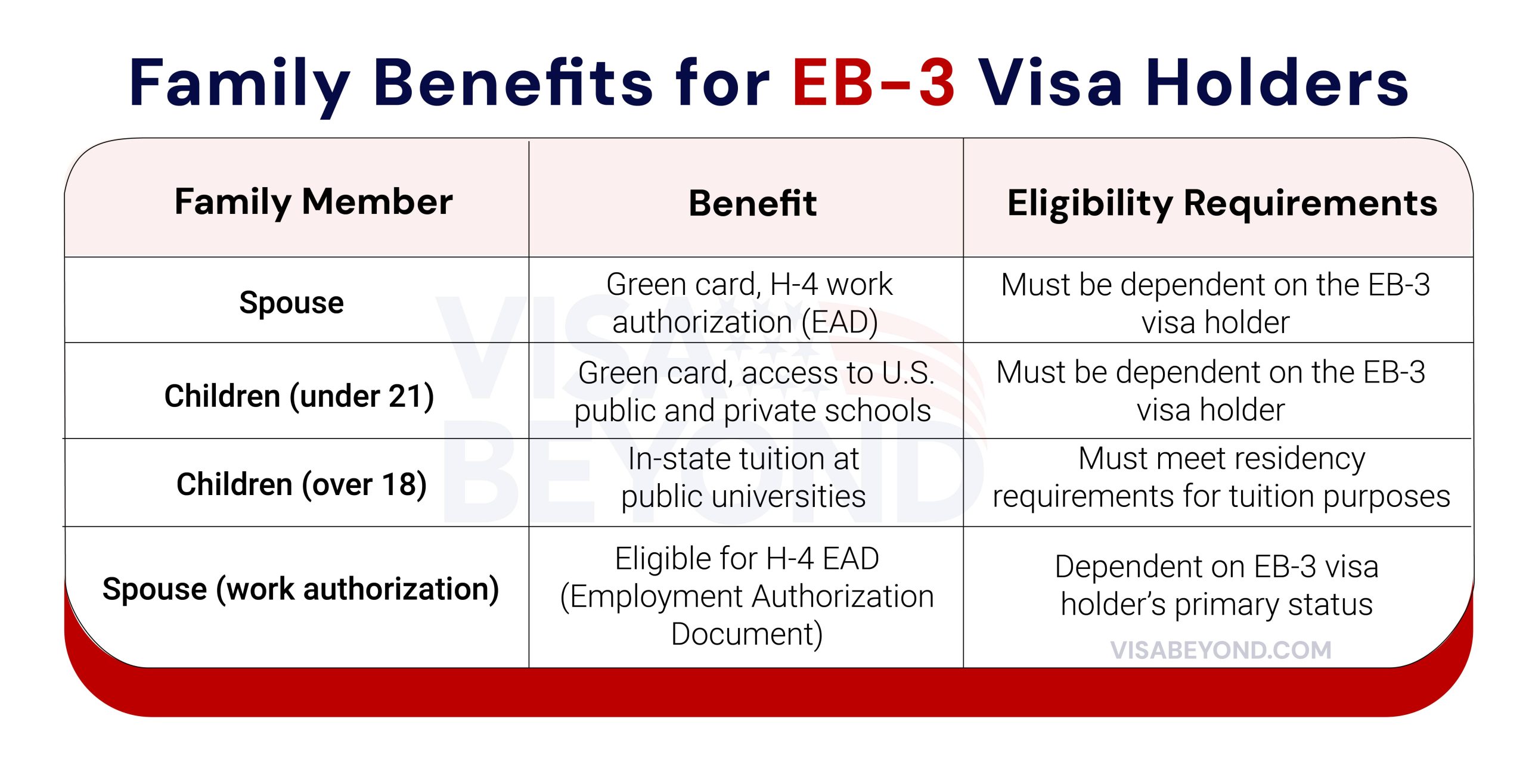
Can Family Members Apply for Green Cards on EB-3 Visa?
Yes, family members (spouse and children under 21) of EB-3 visa holders can apply for green cards as dependents. They are eligible for permanent residency, providing the family with the opportunity to live and work in the U.S.
Work Authorization for Dependents of EB-3 Visa Holders
Spouses of EB-3 visa holders can apply for H-4 work authorization, allowing them to legally work in the U.S. This provides financial flexibility and allows dependents to pursue career opportunities while living in the U.S.
Transitioning from O-1 to H-1B, EB-1, or Other Visas
Children of EB-3 visa holders can benefit from U.S. public and private education, from K-12 schools to higher education institutions. They also qualify for in-state tuition at public universities, making higher education more affordable.
Let’s Make Your U.S. Dreams a Reality.
Common Challenges and Solutions for EB-3 Visa Applicants
Common reasons for O-1 visa denials include insufficient evidence of extraordinary ability, lack of detailed documentation, or discrepancies in your application. Avoid these pitfalls by ensuring your application is thorough, well-documented, and aligns with the O-1 criteria.
What to Do If Your EB-3 Visa Application is Delayed
Delays in the EB-3 visa process can be frustrating but are often manageable with the right approach:
- Verify Your Priority Date: Check if your priority date is current using the monthly Visa Bulletin published by the U.S. Department of State.
- Contact USCIS: If processing times exceed the norm, reach out to USCIS for an update.
- Consider Premium Processing: For Form I-140, premium processing can expedite the decision within 15 days.
- Ensure Complete Documentation: Double-check all submitted documents for accuracy and completeness to avoid further delays.
Appealing an EB-3 Visa Denial: What You Can Do
If your EB-3 visa application is denied, you have options to appeal:
File Form I-290B:
Submit an appeal or motion to reopen/reconsider within 30 days of the denial.
Provide New Evidence:
Include any additional information that supports your eligibility.
Legal Representation:
An attorney can help present a strong case and navigate legal procedures.
Maximizing Your EB-3 Visa Experience
Securing an EB-3 visa is a significant milestone. To fully capitalize on this opportunity, focus on career growth, networking, and utilizing available resources.
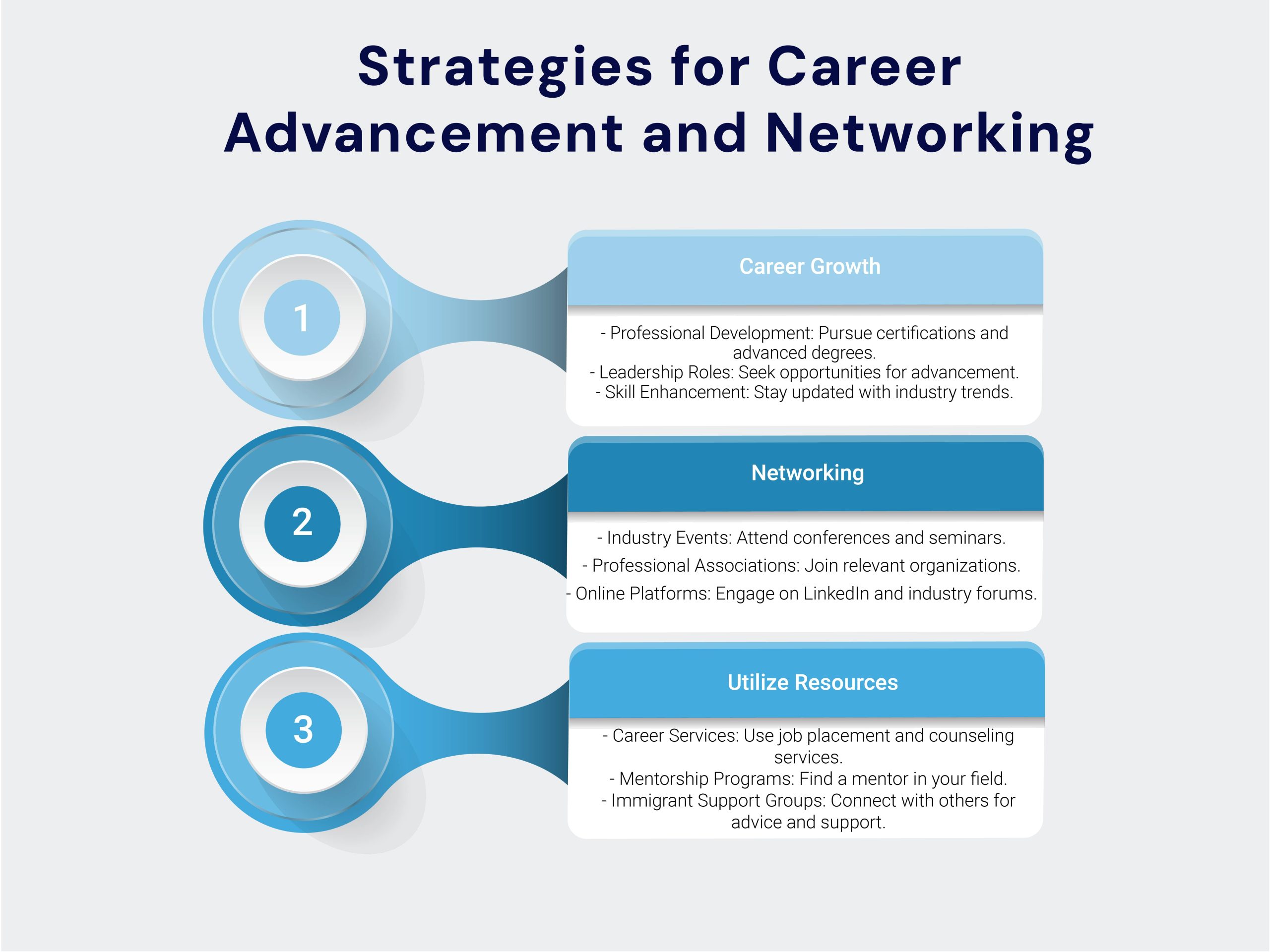
How to Leverage Your EB-3 Visa for Career Growth
The EB-3 visa is your gateway to career growth in the U.S., but to fully benefit, it’s important to take proactive steps. Start by continuously upskilling—enroll in courses or get certifications relevant to your field to boost your credentials. Aim for promotions by taking on bigger projects and showing leadership at work. Finally, focus on networking: attend industry events and connect with peers on LinkedIn to create opportunities. These simple actions can fast-track your professional journey and help you make the most of your EB-3 visa.
Strategizing Long-Term Career Success on an EB-3 Visa
For lasting success on an EB-3 visa, you need a plan. First, set clear career goals—whether it’s getting promoted or switching industries, knowing what you want is key. Next, work on building your personal brand by sharing your expertise through articles or speaking at events. Finally, stay adaptable—market changes happen, and being flexible will help you stay relevant and open to new opportunities. This strategy ensures your career continues to thrive over the long term.
Building a Professional Network as an EB-3 Visa Holder
Networking is essential for career growth as an EB-3 visa holder. Start by attending industry events to meet new people and learn about job opportunities. Make sure you practice reciprocity—help others by sharing your knowledge or offering support. Lastly, be consistent—stay in touch with your contacts and nurture relationships on platforms like LinkedIn. A strong network can open doors to new career opportunities and provide valuable support throughout your visa journey.
Resources and Support for EB-3 Visa Holders
As an EB-3 visa holder, there are resources to help you succeed. Immigration support groups can guide you through visa-related questions and legal challenges. For career help, tap into mentorship programs and career counseling services that offer guidance on job searches and professional development. Also, connect with community groups that help immigrants adjust to life in the U.S. and build support networks. These resources make your transition smoother and your path to success easier.
Why EB-3 Visa is a Valuable Option for Skilled Workers?
The EB-3 visa is a great choice for skilled workers seeking long-term opportunities in the U.S. Its broad eligibility means it’s available to skilled, professional, and even unskilled workers. It offers a clear pathway to permanent residency, allowing you and your family to secure green cards. Plus, the visa opens doors to career advancement, giving you access to a robust job market and professional growth. For those looking to establish a stable and prosperous future in the U.S., the EB-3 visa is an excellent option.
Latest News.
From the blog
"*" indicates required fields
